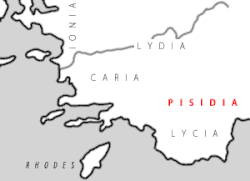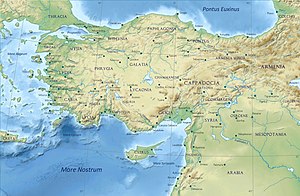How To Pronounce Pisidia In The Bible
| Pisidia (Πισιδία) | |
|---|---|
| Aboriginal Region of Anatolia | |
 Theatre of Termessos | |
| Location | Southern Anatolia |
| Country existed | - |
| Language | Pisidian |
| Notable cities | Termessos, Sagalassos |
| Roman province | Asia, Galatia |
 | |

Pisidia (; Greek: Πισιδία , Pisidía ; Turkish: Pisidya) was a region of ancient Asia Minor located n of Pamphylia, northeast of Lycia, west of Isauria and Cilicia, and south of Phrygia,[1] corresponding roughly to the modern-24-hour interval province of Antalya in Turkey. Amid Pisidia'due south settlements were Antioch(ia) in Pisidia, Termessos, Cremna, Sagalassos, Etenna, Neapolis, Selge, Tyriacum, Laodiceia Katakekaumene and Philomelium.
Geography [edit]
Although Pisidia is close to the Mediterranean Body of water, the warm climate of the south cannot pass the height of the Taurus Mountains. The climate is too dry for timberland, but crop plants grow in areas provided with h2o from the mountains, whose annual average rainfall is c. 1000 mm on the peaks and 500 mm on the slopes. This water feeds the plateau. The Pisidian cities, mostly founded on the slopes, benefited from this fertility. The irrigated soil is very suitable for growing fruit and for husbandry.
History [edit]
Early history [edit]
The area of Pisidia has been inhabited since the Paleolithic age, with some settlements known from historical times ranging in historic period from the eighth to tertiary millennium BC.
Late Bronze and Fe Ages [edit]
The ancestors of the classical Pisidians were probable present in the region before the 14th century BC, when Hittite records refer to a mountain site of "Salawassa", identified with the subsequently site of Sagalassos. At that time, Pisidia appears to take been role of the region the Hittites called Arzawa. The Pisidian linguistic communication is poorly known, but is causeless to exist a member of the Anatolian branch of Indo-European languages.
At that place is a lacuna (gap) in the text of Herodotus (7.76), but it is doubtful to surmise a reference to the Pisidians in that passage.[2] There can be little doubt that the Pisidians and Pamphylians were the same people, but a distinction between the 2 seems to have been established at an early period. Herodotus, who does non mention the Pisidians, enumerates the Pamphylians among the nations of Asia Small-scale, while Ephorus mentions them both, correctly including the 1 among the nations on the interior, the other amid those of the coast. Pamphylia early on received colonies from Greece and other lands, and from this cause, combined with the greater fertility of their territory, became more civilized than its neighbor in the interior. Pisidia remained a wild, mountainous region, and one of the most hard for outside powers to rule.
Every bit far dorsum as the Hittite menstruation, Pisidia was host to independent communities non under the Hittite yoke. Known for its warlike factions, it remained largely independent of the Lydians, and even the Persians, who conquered Anatolia in the sixth century BC, and divided the area into satrapies for greater control, were unable to cope with constant uprisings and turmoil.
Hellenistic flow [edit]
Alexander the Smashing had a somewhat ameliorate fortune, conquering Sagalassos on his way to Persia, though the city of Termessos defied him. Subsequently Alexander died, the region became role of territories of Antigonus Monophthalmus, and mayhap Lysimachus of Thrace, after which Seleucus I Nicator, founder of the Seleucid Dynasty of Syria, took command of Pisidia. Under the Seleucids, Greek colonies were founded at strategically important places and the local people Hellenised. Even and so, the Hellenistic kings were never in complete control, in part because Anatolia was contested between the Seleucids, the Attalids of Pergamon, and the Galatians, invading Celts from Europe. The cities in Pisidia were among the concluding in western Anatolia to fully prefer Greek civilisation and to coin their ain money.
Pisidia officially passed from the Seleucids to the Attalids as a issue of the Treaty of Apamea, forced on Antiochos III of Syrian arab republic past the Romans in 188 BC. Afterwards Attalos Iii, the final king of Pergamon, bequeathed his kingdom to Rome in 133 BC as the province of Asia, Pisidia was given to the Kingdom of Cappadocia, which proved unable to govern information technology. The Pisidians cast their lot with pirate-dominated Cilicia and Pamphylia until the Roman rule was restored in 102 BC.

A 15th-century map showing Pisidia
In 39 BC Marcus Antonius entrusted Pisidia to the Galatian client rex Amyntas and charged him with suppressing a people of the Taurus Mountains known as the Homonadesians, who sometimes controlled the roads connecting Pisidia to Pamphylia.
Roman and Byzantine dominion [edit]
Afterwards king Amyntas of Galatia was killed in the struggle in 25 BC, Rome made Pisidia office of the new province of Galatia. The Homonadesians were finally wiped out in 3 BC.
During the Roman period Pisidia was colonized with veterans of its legions to maintain control. For the colonists, who came from poorer parts of Italy, agriculture must have been the area's primary attraction. Nether Augustus, eight such colonies were established in Pisidia, and Antioch and Sagalassos became the near important cities. The province was gradually Latinised. Latin remained the formal language of the area until the stop of the 3rd century.
Pisidia became an of import early Christian center. Paul the Apostle preached in Antioch on his first journeying.[three] He also visited the area in his 2d[4] and third[5] journeys. After the Emperor Constantine's legalization of Christianity in 311, Antioch in Pisidia (which has various namesakes, including the Patriarchate in Syria) played an important office as the Christian metropolitan encounter likewise equally being the uppercase of the civil province of Pisidia. Well-nigh Pisidian cities were heavily fortified at that time due to civil wars and foreign invasions.
The surface area was devastated by an earthquake in 518, a plague around 541–543, and another convulsion and Arab raids in the center of the seventh century. Afterward the Muslim conquest of Syria disrupted the trade routes, the surface area declined in importance. In the 8th century the raids increased. In the 11th century the Seljuk Turks captured the area and founded the Seljuk Sultanate in Primal Anatolia. Pisidia frequently changed easily between the Byzantine Empire and the Turks. In 1176, Sultan Kılıçarslan defeated Manuel Komnenos in the Battle of Myriocephalon (chiliad heads).
Notable people [edit]
- George of Pisidia (7th century) - Byzantine poet
See also [edit]
- Ancient regions of Anatolia
- Pisidian language
References [edit]
- ^ The New Century Classical Handbook; Catherine Avery, editor; Appleton-Century-Crofts, New York, 1962, p. 896: "Pisidia...a territory in Asia Minor. It was divisional by Phrygia on the N, Isauria and Cilicia on the E, Pamphylia on the Southward, and Lucia on the SW"
- ^ Gonzales, Matthew (2005). "The Oracle and Cult of Ares in Asia Minor". Greek, Roman and Byzantine Studies. 45 (3): 262–263, northward. 3 and esp. north. v.
- ^ Acts 13:13–52 and 14:21–23
- ^ Acts 16:1
- ^ Acts 18:23
Farther reading [edit]
- Bean, G. Eastward. "Notes and Inscriptions from Pisidia. Role I." Anatolian Studies, vol. 9, 1959, pp. 67–117. JSTOR, www.jstor.org/stable/3642333. Accessed 24 April. 2020.
Sources and external links [edit]
- Termessos on the Web, comprehensive guide to the striking Pisidian metropolis
- Sagalassos on the Spider web, comprehensive guide to the hitting Pisidian metropolis
- Termessos Guide and Photo Anthology
- Sagalassos Guide and Photo Anthology
- Herbermann, Charles, ed. (1913). . Catholic Encyclopedia. New York: Robert Appleton Company.
- Aboriginal Sagalassos: Pride of Pisidia
- Beyaz Arif Akbas: "Sagalassos: City of Fairies", Adrianapolis, Yalnizgoz Yay. 2010, ISBN 978-1-4536-1300-9. http://en.calameo.com/read/0002983841c7acaa28dc8
Coordinates: 37°18′N 30°eighteen′E / 37.iii°N xxx.3°E / 37.three; 30.three
Source: https://en.wikipedia.org/wiki/Pisidia

0 Response to "How To Pronounce Pisidia In The Bible"
Post a Comment